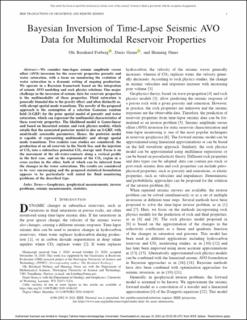| dc.contributor.author | Forberg, Ole Bernhard | |
| dc.contributor.author | Grana, Dario | |
| dc.contributor.author | Omre, Henning | |
| dc.date.accessioned | 2022-11-16T09:48:21Z | |
| dc.date.available | 2022-11-16T09:48:21Z | |
| dc.date.created | 2021-11-22T10:57:59Z | |
| dc.date.issued | 2021 | |
| dc.identifier.citation | IEEE Transactions on Geoscience and Remote Sensing. 2021, 59 (11), 9104-9119. | en_US |
| dc.identifier.issn | 0196-2892 | |
| dc.identifier.uri | https://hdl.handle.net/11250/3032076 | |
| dc.description.abstract | We consider time-lapse seismic amplitude versus offset (AVO) inversion for the reservoir properties porosity and water saturation, with a focus on monitoring the evolution of water saturation in a dynamic setting of ongoing production. We operate in a Bayesian framework based on the integration of seismic AVO modeling and rock physics relations. One major challenge in the inversion of seismic data for reservoir properties is the multimodality of these properties. Fluid saturation is generally bimodal due to the gravity effect, and often distinctly so, with abrupt spatial mode transitions. The novelty of the proposed approach is the assumption of a selection Gaussian random field (S-GRF) for the prior spatial model of porosity and water saturation, which can represent the multimodal characteristics of these reservoir properties. The likelihood model is Gauss-linear and based on linearized seismic and rock physics models, which entails that the associated posterior model is also an S-GRF, with analytically assessable parameters. Hence, the posterior model is capable of representing multimodality and abrupt spatial mode transitions. Two realistic case studies are considered; the production of an oil reservoir in the North Sea, and the injection of CO 2 into a subsurface potential CO 2 storage unit. Focus is on the movement of the oil–water-contacts along a vertical profile in the first case, and on the expansion of the CO 2 region in a cross section in the other, both of which can be inferred from the changes in the water saturations. The results are considered to be very encouraging and the proposed statistical formulation appears to be particularly well suited for fluid monitoring problems of the described type. | en_US |
| dc.language.iso | eng | en_US |
| dc.publisher | Institute of Electrical and Electronics Engineers (IEEE) | en_US |
| dc.title | Bayesian Inversion of Time-Lapse Seismic AVO Data for Multimodal Reservoir Properties | en_US |
| dc.type | Peer reviewed | en_US |
| dc.type | Journal article | en_US |
| dc.description.version | acceptedVersion | en_US |
| dc.rights.holder | © IEEE. Personal use of this material is permitted. Permission from IEEE must be obtained for all other uses, in any current or future media, including reprinting/republishing this material for advertising or promotional purposes, creating new collective works, for resale or redistribution to servers or lists, or reuse of any copyrighted component of this work in other works. | en_US |
| dc.source.pagenumber | 9104-9119 | en_US |
| dc.source.volume | 59 | en_US |
| dc.source.journal | IEEE Transactions on Geoscience and Remote Sensing | en_US |
| dc.source.issue | 11 | en_US |
| dc.identifier.doi | 10.1109/TGRS.2020.3046102 | |
| dc.identifier.cristin | 1957173 | |
| cristin.ispublished | true | |
| cristin.fulltext | postprint | |
| cristin.qualitycode | 2 | |
